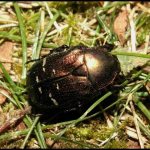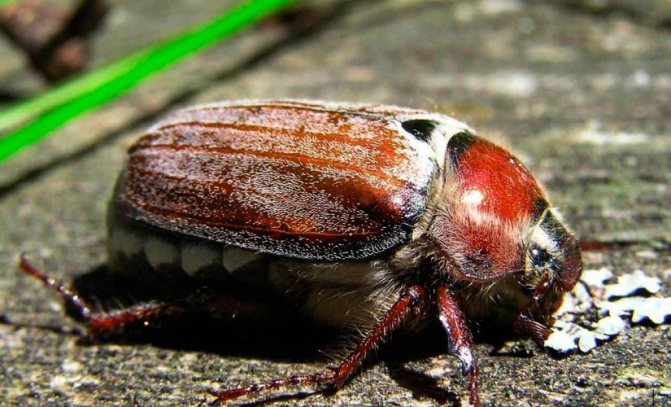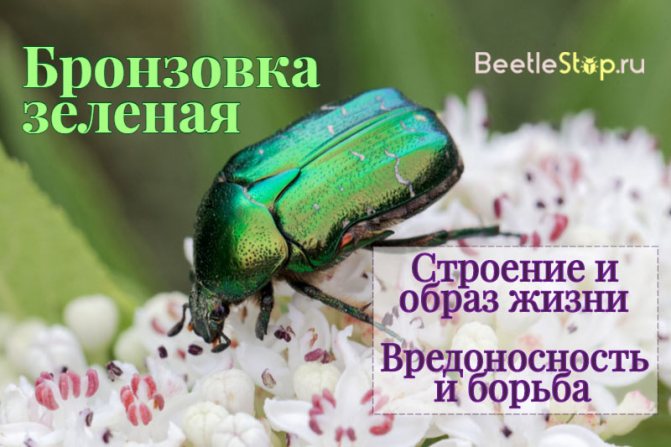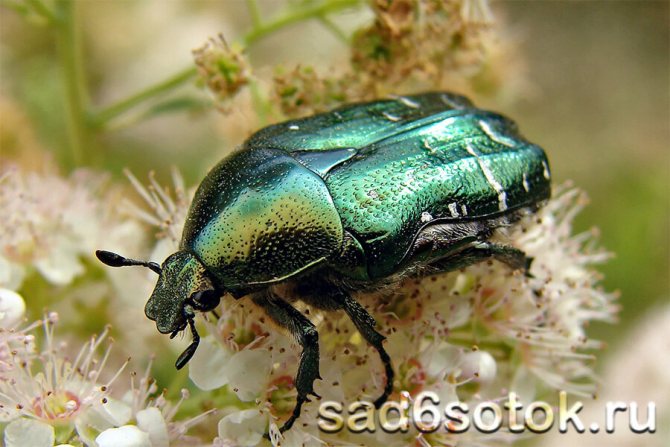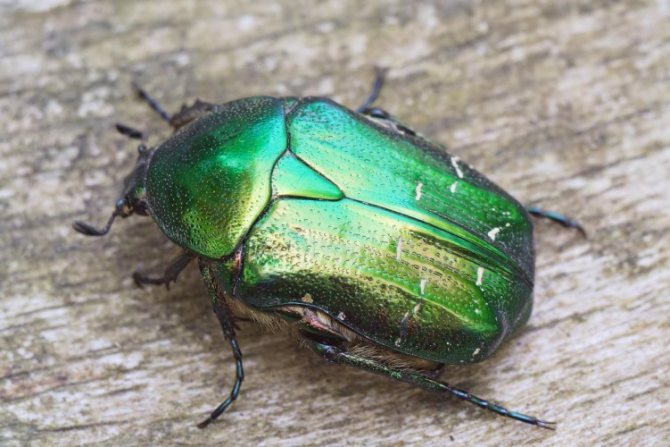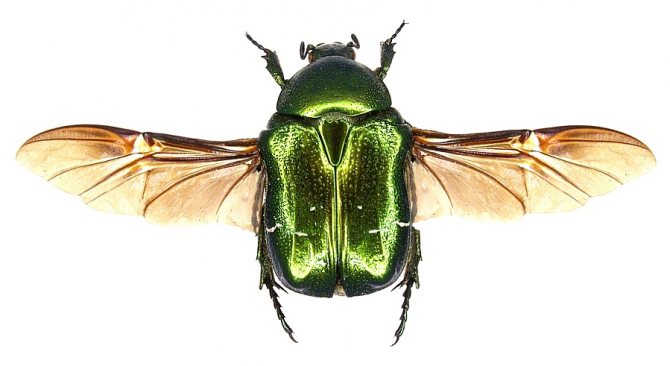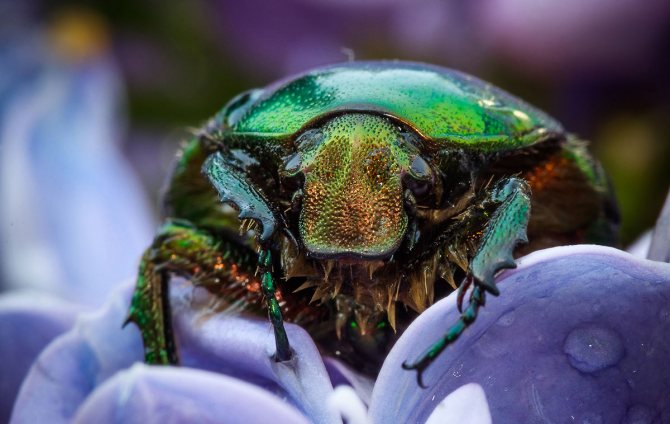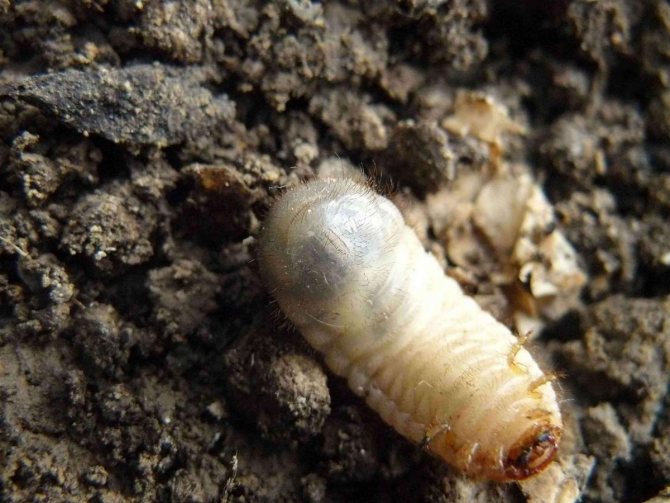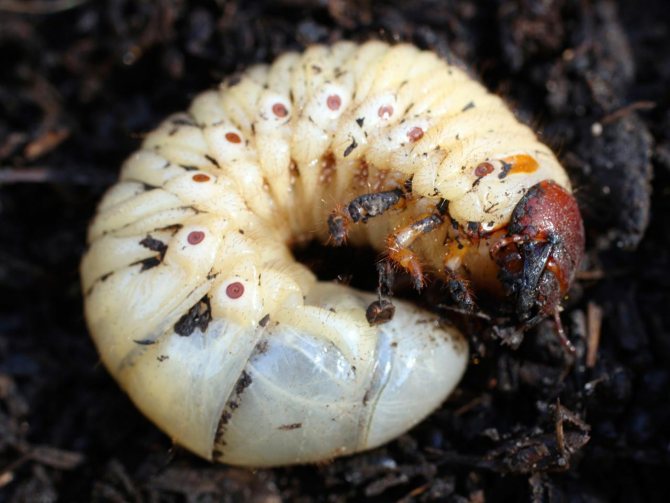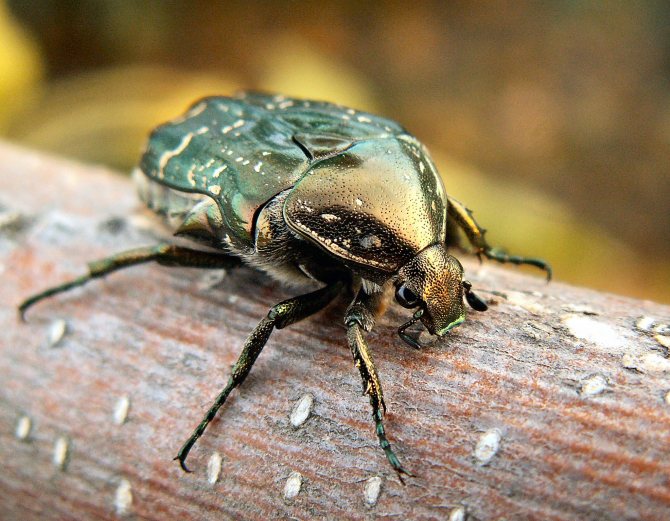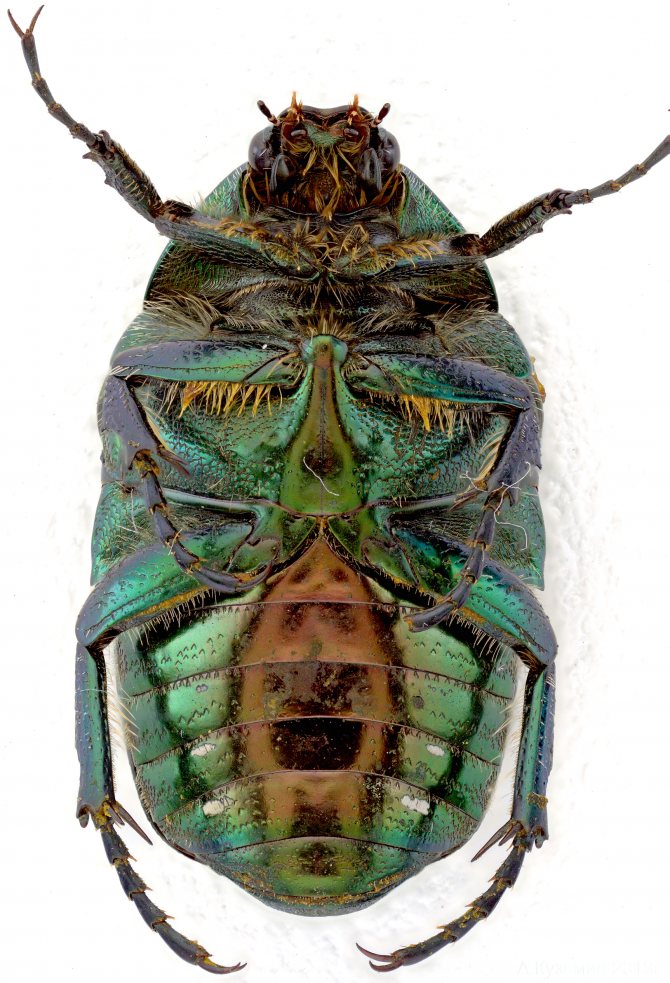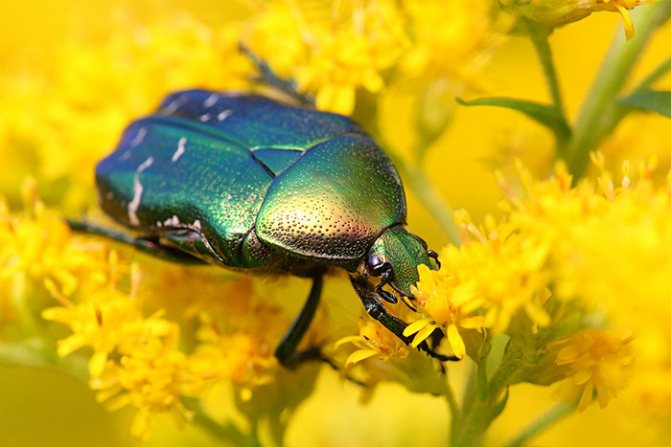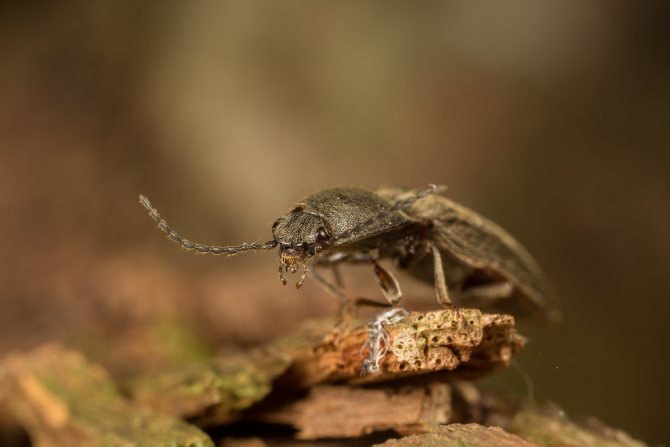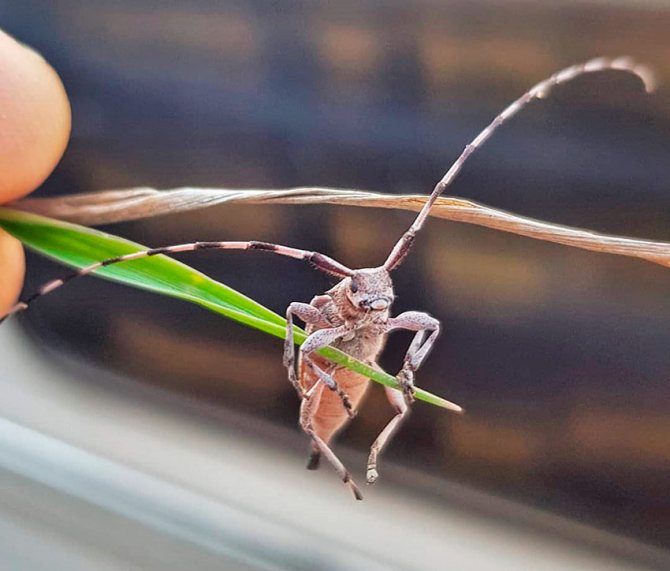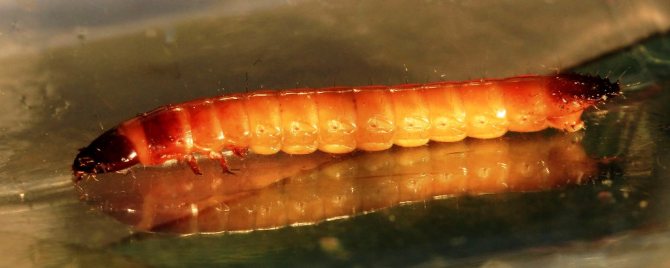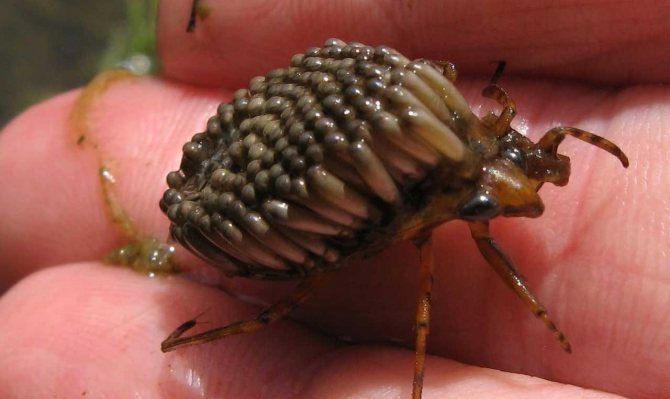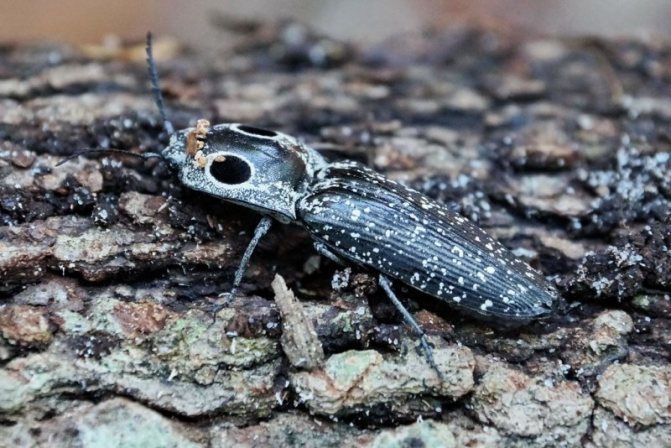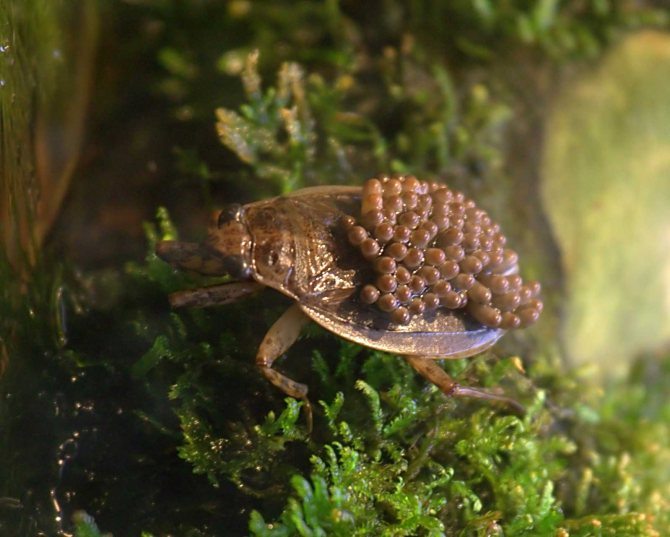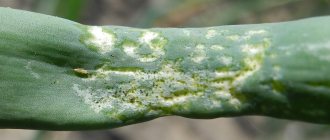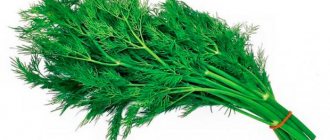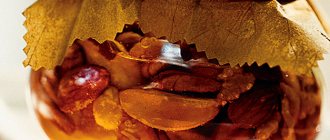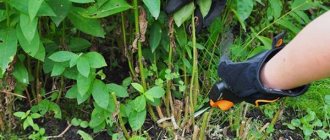Bronzovka beetle does not mean a specific type of insect, but denotes a subfamily belonging to the family of lamellar beetles, in which there are more than 4,000 species. Most of the bronzes are from the tropics. At least 33 species of these beetles live in Russia. The family includes not only bronzes, but also rhinoceros beetles. Also this family includes one of the main pests of agriculture - the May beetle.
Types of bronzes
The beetles get their name from the metallic sheen of their shells. But beetles of this subfamily can not always be identified at first glance. Some have a simple black carapace without a hint of metallic sheen. The most recognizable is golden bronze - the most widespread and numerous species in Eurasia. Some Eurasian species:
- golden;
- smooth;
- smelly;
- furry;
- marble;
- copper.
Shamil's bronze is a rare species, endemic to the inland Dagestan.
Power features
Bronzovka beetle has a very exquisite taste. It feeds on flowers not only from wild, but also cultivated trees or shrubs. In addition, young shoots and leaves are of interest to him. It is not uncommon for beetles to be found inside juicy fruits. More specifically, the golden bronze loves pears, mountain ash, maple, sage, sorrel, rye, mustard.
It must be said that the presented insect can gather in large enough quantities exactly where the tree sap flows to the surface. Golden bronze is a gluttonous beetle. It does a lot of harm to plants, but it is still not capable of completely destroying the crop.
General characteristics of beetles
The body is short. The back line is almost straight. The transitions from the back to the sides are rounded. The head is small, directed downward and forward. This family is called lamellar owls because of the special structure of the antennae, which, if necessary, the insect unfolds into a fan of plates.
Interesting!
The flight speed of the bronzes is much higher than that of other flying beetles.
Such a success in bronzes is due to the special structure of the elytra: there are small notches on the sides between the abdomen and the rigid plate. Through them, insects release translucent brown wings. The elytra remain folded and do not inhibit the bronze. Other beetles are forced to open the elytra, which stick up and to the sides in flight and greatly interfere with flight.
Lifestyle
The bronze insect lives in forests, gardens, parks, meadows and vegetable gardens. Females lay eggs in compost and manure heaps, rotten stumps, in the hollows of dead trees. Larvae and adults overwinter in approximately the same places. It is important to note that the bronzes prefer hardwood; rotten spruce and pine trees do not attract them.
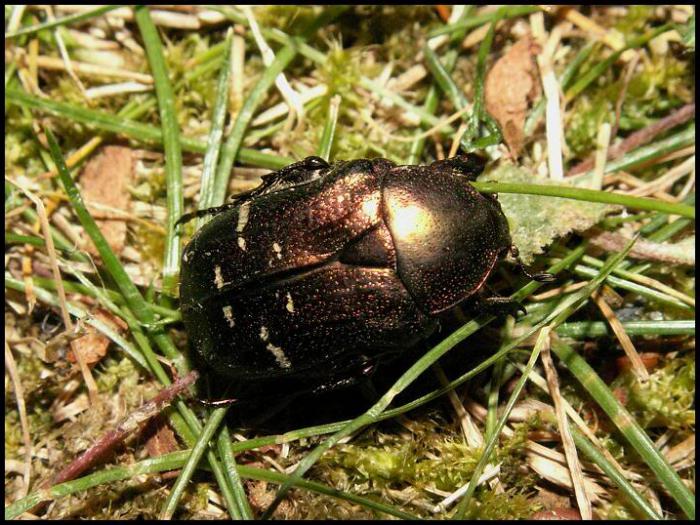
It is believed that bronze women have not so many natural enemies. The larvae are parasitized by the scolia and typhia wasps, as well as the tahina fly. Adult beetles become prey for birds. Bronze animals, as a rule, do not eat, since these insects produce a special toxin that can be fatal for a small predator.
Beetles are active during the daytime, especially if the weather is dry and sunny.
Bronze larvae are beneficial: utilizing rotting wood, weed roots and organic remains, they contribute to the formation of a fertile soil layer, which has a positive effect on the state of the latter.
But the mouth apparatus of adult beetles is not adapted to absorb rough food. Golden bronze, the photo of which is located below, feeds on plant flowers (stamens, pistils and ovaries).
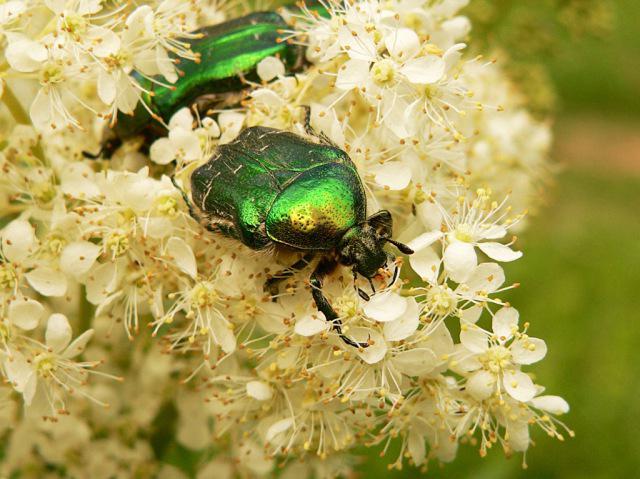

Young leaves and fruits also suffer from bronzes. Beetles also do not disdain tree sap.Unfortunately, bronzovki love ornamental plants: roses (because of this they are even called "pink beetles"), peonies, raspberries, grapes, strawberries, as well as flowers of fruit trees (cherries, apple trees). For them, any field, meadow or ornamental plants with sweet juice are of interest.
Gardeners do not like bronzes for ugly eaten flowers and "skeletonized" leaves.
Coloration
The color of the bronzes is very diverse. These beetles do not always have a beautiful color. Even within the same species and habitat, the color of the bronzes can vary greatly.
On a note!
Sometimes the color is formed by special highlights that completely cover the main background. The color can be with or without a metallic sheen.
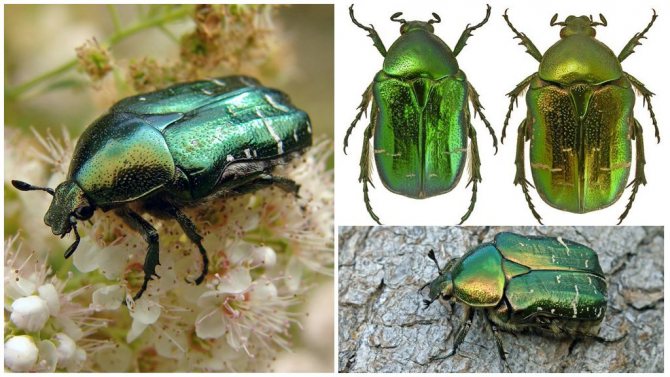

Bronzovka beetle
With a metallic luster, i.e. shiny, oily-shiny and matte-shiny:
- green with various shades is the most common in the group;
- blue;
- copper red;
- purple;
- purple;
- bronze;
- black with a metallic sheen.
In beetles without a metallic sheen, the color can be:
- black;
- brown;
- brown;
- red of different shades;
- green;
- yellow;
- white with an olive or gray tint.
On a note!
All members of the family have a characteristic feature: light spots, shaped like the edges of scales.
Spots can be:
- yellowish;
- clay yellow;
- white;
- pink.
They are located on the elytra, pronotum, underside of the abdomen, and on the upper part of the hind legs. The spots can be of different sizes and shapes. Sometimes these marks merge, covering most of the beetle's body. Most often this happens on the elytra.
How can you get rid of them?
If a kozheed is wound up in the house, urgent measures must be taken. You should choose a method for exterminating the pest. Destruction methods can be:
- folk;
- professional;
- chemical;
- household.
spring-cleaning
Before using chemistry in the fight against an infestation of skin bugs, it is necessary to examine the housing to determine the amount of the pest. If it is insignificant, you can get by with a thorough cleaning. This is the first step to getting rid of your unpleasant neighbor. Cleaning is carried out in 4 stages:


- Throw away things affected by pest larvae. If the interior items are valuable, you can try to freeze them or boil them. If possible, things should be washed with detergent in hot water.
- Eliminate dust from all surfaces by means of special disinfectants.
- Carry out cleaning of upholstered furniture and carpets. In the fight against the pest, a washing vacuum cleaner will help. Vacuuming is necessary every day, remembering to change the dust bag.
- Thoroughly wash the floor using disinfectants such as "Mister Muscle" or "Mister Proper".
By carrying out such cleaning, you can not only reduce the number of parasites, but also identify the places of their deployment.
Bullying
If a large pest colony is found, you will have to resort to baiting. The combination of different means and methods of struggle is the key to success in the extermination of skin bugs. It is advisable to combine the use of professional insecticides with folk remedies.
When baiting, you should take into account a number of features of the life of kozheedov:
- Pest larvae do not tolerate light. They are located in places inaccessible to the sun's rays.
- Larvae develop faster at warm temperatures. Open windows before applying insecticides.
- The larvae are very mobile, therefore large surface areas are subject to processing.
Chemicals
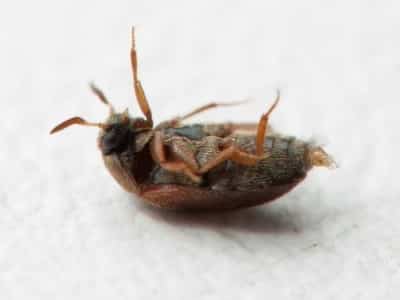

In the fight against the skin beetle, 4 types of chemical agents are applicable. We are talking about the following purchased drugs:
- disinfectants - means that destroy an insect when it enters its body;
- fumigators, providing for the spread of toxic substances by air;
- antimolent drugs;
- insecticides belonging to the pyrethrin group like "Permethrin".
On the eve of the use of chemicals, it will be necessary to remove children and pets from the premises.
Range of disinfectants
Disinfectants used in the fight against insect pests differ from each other in the method of use, price, efficiency. Among the most popular drugs you can see:
- Boric acid powder... The pharmaceutical preparation is affordable and effective. It is used in the place of accumulation of skin beetles.
- "Difox"... On the basis of the drug, a solution is prepared: 2 ml of the product per 1 liter of water. It is sprayed onto surfaces affected by insects. With a large number of pests, the effectiveness of the drug is low.
- Ready-made aerosols like "Molemora", "Raptor", "Dichlorvos", "Karbofos", "Inta-Vira". The contents of the vial are sprayed into the place of accumulation of insect pests. The result lasts for 6 months.
You can also fight parasites using special sticky traps.
Advantages and disadvantages of fumigators
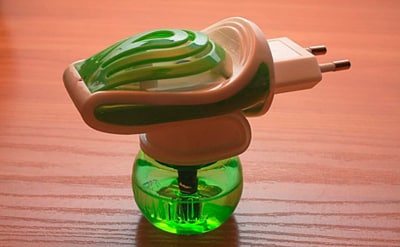

The use of special devices-fumigators, powered by a network and spraying substances toxic to insects, allows you to achieve positive results in the fight against skin debris. Their advantage is the ability to cover a large area in a room affected by parasites.
The use of fumigators has several disadvantages:
- the need for an electrical connection;
- the need to place the device in close proximity to places where insects accumulate;
- achieving a result is possible only with regular use of the product.
"Antimol": advantages and disadvantages
Preparations for moths like "Antimoli" and "Fandal" are affordable, effective in the fight against the skin beetle. Their disadvantage is unpleasant odor.
Permethrin
A naturally occurring insecticide called "Permethrin" attacks the insect's nervous system, causing paralysis. The product in the form of a solution or aerosol is highly effective. You can buy it at the pharmacy.
Folk remedies
Clothes affected by bugs are subjected to freezing. The method is applicable not only for fur coats, but also for carpets. You should take things out in the cold for 5-10 hours. At a temperature of -15 ° C, the heat-loving skin dies. The fragrance is harmful to insects:
- cedar;
- lemon balm;
- lavender.
It is advisable to leave a sachet with essential oil and herbs in places where parasites accumulate. Traditional methods are not as effective as the use of purchased chemicals.
Step three: prevention
Preventive measures will help prevent the problem. They are required to be carried out after the treatment has been carried out in order to avoid secondary damage to the housing by insect pests. In the list of preventive measures, you can see:
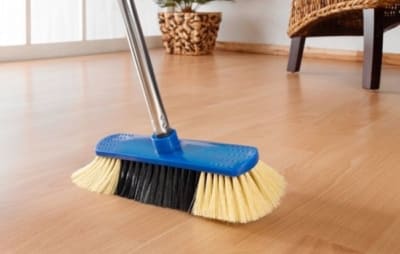

- regular wet cleaning;
- adding vinegar to the water for washing floors (1 tbsp. l. per 1 l);
- using soapy water to treat baseboards and floor crevices;
- timely removal of garbage, washing dirty dishes;
- equipping window openings with mosquito nets;
- storage of cereals, flour, dried fruits in glass containers with a tight-fitting lid.
Golden bronze
Another official name for the beetle is common bronze. It is sometimes called the green may beetle. The name is completely wrong, since these two species differ not only in color, but also in structure, as well as in the time of summer. If we compare the bronzovka with the May beetle in the photo, having removed the insects from above and behind, it will be seen that the May's abdomen is much longer than the elytra and has a sharp posterior tip. The elytra of the May is ribbed and directed at a greater angle to the ground than that of the bronze.
Golden Bronze is a small beetle. Significantly larger specimens are found among Russian Coleoptera. But it cannot be called small either. The body length of the golden bronze is 13-23 mm, with a width of 8-12 mm.
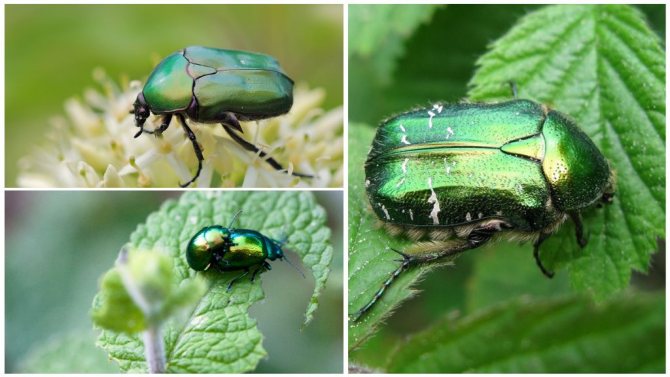

Ordinary bronze
On a note!
Golden bronze has many color variations. The only common feature: it is a beetle with a shiny metallic coloration. You can even find a blue beetle.
Color variations
The main color options:
- The upper torso is copper-purple with a metallic sheen. The bottom is black with a purple sheen.
- Black without shine.
- "Normal" emerald beetle, but there are no scales on the back, there are only two specks.
- Iridescent beetle. Pronotum and head emerald green with gold tint. When illuminated from the side, the reflection is dark blue. The elytra are green. When light falls from the side, they are violet-brown. There are no white spots.
- Elytra, pronotum, and head are green or golden-green. The beetle is covered with stubble.
- Against the main background, large and numerous white spots, which often merge into transverse wavy lines.
- The back and legs are golden-red or golden-green. There is a strong copper-red tint.
- Dark purple color. Elytra with characteristic white spots. There are no spots on the abdomen and pronotum.
- The top is copper-red or copper-brown, the bottom is bronze-green. Many spots on the elytra.
- Above, the color is dark bronze or dark bronze-green. Bottom - black.
- Scutellum, pronotum, and head of dark copper-red color. The elytra are black-green. The lower part is black.
- Olive green color without spots.
- The upper side is dark purple with characteristic spots, the lower side is dark red with a strong purple sheen.
- The back is golden green. It may be coppery red.
- The upper part is green or golden green, the lower part is green.
- The top of the beetle is green, the back of the abdomen is purple-red, the chest side is purple.
- The top is golden-green or copper-red, without spots.
- Dark blue back with a green tint. Elytra are white spots.
- The back is bright blue, the chest is black-blue, blue-green, blue.
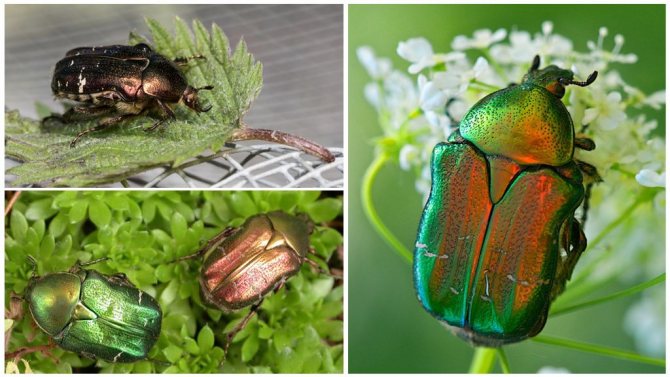

Bronze color
Bronzes are very "democratic" in their color. In addition to those listed, there are about a dozen different variations.
On a note!
Another pearlescent green beetle, the mint leaf beetle, is sometimes confused with bronze. This green bug is 2 times smaller than bronze and has a convex shell shape. It eats the leaves of essential oil plants and does much more harm than bronzovka. But the leaf beetle belongs to a different family.
Lifestyle
Golden bronzes are common throughout the Eurasian continent. They are not found only in the mountains and deserts. Bronzes are eaten by flower cores. They have a wide menu, they are capable of damaging the flowers of cultivated and wild plants. Very often they can be found on roses, where they are taken to the very core. But bronzes are not capable of causing serious harm to the garden.
Interesting!
Gardeners do not like these insects, since they believe that the larva of the bronze beetle eats the roots of garden crops. In fact, the plants are harmed by the May beetle larvae, similar to the offspring of the bronzes.
Bronzers are very light and heat-loving creatures. They are active during the day in hot sunny weather. On cloudy days, the bronzes are apathetic. They sit almost motionless on the cores of flowers and do not try to fly. In rainy and cold weather, they hide in a shelter:
- under the sockets of flowers;
- in bedding on the ground;
- under the roots of plants.
At night, beetles also descend to the ground.
The similarities between Bronzovki and May brown beetles are the time of summer. Bronzes are thermophilic and the time of their life depends on the climate in the region. In the northern regions, beetles only appear in June, while in the southern years, bronzes begin from mid-May.
The period of development of the beetle from egg to adult can take from several months to a year, depending on when the eggs were laid. If the insect managed to develop by autumn before the adult stage, the adult hibernates in shelters and wakes up much earlier than the main summer time of this species.
What does the bronzovka beetle eat?
What the bronzovka does not look like the May beetle is the food supply. May beetle damages leaves of bushes and trees. The bronze eats the core of the flowers. The beetle larva (beetle) feeds on the roots of living plants. Bronzes - rotting organic matter.
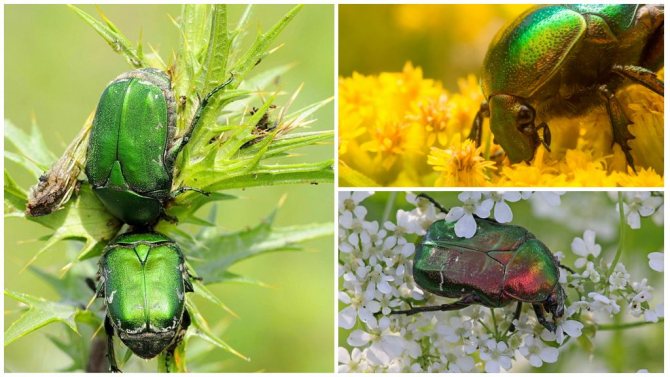

Bronzovka beetle nutrition
The insect eats flowers of plants from 31 families. The list includes rosaceae, mulberry, umbrella, dogwood, buttercup and many other families.
Larva
All larval stages of lamellar beetles are similar to each other. And the larvae of representatives of this subfamily are also so similar that it is often difficult to understand the types of insects not only in description, but also in photos. In order not to remember the signs that distinguish one C-shaped larva from another, gardeners prefer to fight all at once. Measures to combat the bronze beetle have not been developed, since it cannot seriously harm the crop. The years of these shiny green beetles begins after the fruit trees have faded. Flowers can only be damaged by individual individuals that emerged from hibernation earlier than the bulk of bronzes.
On a note!
Some types of bronze in Russia are under state protection.
The larvae of these beetles process organic matter more than earthworms. As a result, the benefits from the larvae are greater than the harm from the adults. And given that the three species are under protection, it is easier to separate different types of larvae.
The differences between the larvae of the bronzovka and the May beetle are clearly shown in the table:
| Bronzovka | Khrushch |
| Eats rotting organic matter | Eats living plant roots |
| Body covered with stubble | The body is smooth |
| Legs are short, non-functional | Paws are long, tenacious, allowing for fast movement |
| Body of the same diameter along the entire length | The body is strongly thickened in the tail. |
| The head is small, inconspicuous compared to the diameter of the body | The head is huge compared to the bronze one. The diameter of the head is equal to the diameter of the body |
| Mandibles are small, weak | Powerful gnawing mandibles |
At home, only those who are not afraid of worms and insects can understand the larvae. The rest just kill everyone.
On a note!
You can save the future harvest by collecting adult bronzes by hand.
Folk remedies
The bronze beetle (what the pest feeds on, you already know) flies well. Naturally, in this case, it is better not to use chemicals. They will harm trees. The fact is that in this way you can destroy other insects that provide pollination. In addition, chemicals can build up in the fruit. Although, in some cases, you can apply poison to the Colorado potato beetles. Moreover, it is better to spray not the plants themselves, but the soil around them.
You can also bury Medvetox under the bushes. It contributes to the destruction of insects that burrow into the ground at night. You can also kill the larvae very quickly. To do this, add "Thunder", "Bazudin" to the places of their development. These drugs are usually sold in granules.
Liquid smoke can be used to repel insects. Just 3 tablespoons are enough for a bucket of water. In order for the mixture to adhere well to the leaves, you need to add a little soap (you can liquid) or washing powder to it.
You can also apply an infusion of wood ash. To prepare the solution, you need to use 1 glass of raw materials, which is diluted in 5 liters of liquid. Ash needs to be infused for at least 5 days. After that, also add liquid soap to the composition.
Smooth bronze
Very similar to one of the options for golden bronze - smooth bronze beetle, included in the Red Book of the Moscow Region. This species prefers old forests and parks where there are many rotten trees.
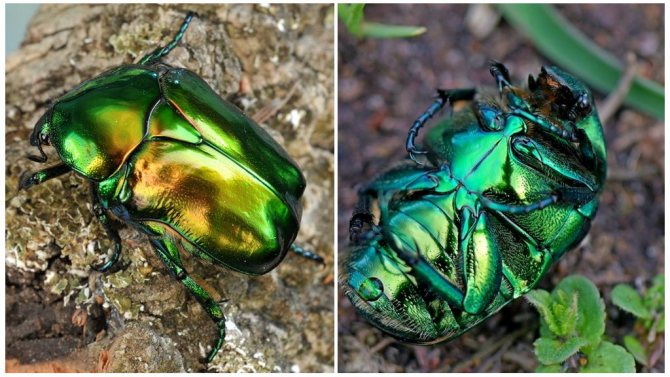

Smooth bronze
Distributed in Southern Europe. In Russia, in the north, the border of the range passes through Kaliningrad, Voronezh, Samara. In the south - across the border with Ukraine to Orenburg.
This beetle with a green shiny back is larger than its "relative". Its body length is up to 3 cm. There are no white marks on the elytra and cephalothorax. The elytra are cast in either a golden or copper-red sheen. Legs and lower body with bluish tint.
Giant bugs - who are they?
For joy or misfortune, there are no giant water bugs in our area. Giant water bug is a foreign tropical creature. Belongs to the genus Belostoma. Reaches a length of 15 cm. The color is brown with different tints. The frightening appearance of an insect does not mean at all that it is dangerous to humans. Giant water bugs have 3 pairs of limbs. The front ones are bent in the form of pincers. With them, the predator grabs the prey and attracts to itself.
Hunting process and food
Giant water bugs can be found in bodies of stagnant water. Belostoma giant water bug prefers to hunt at night. Water bugs choose a convenient place and simply freeze. When a prey approaches, the giant bug quickly grabs it with its claws. In the saliva of the belostoma there is a substance with a nerve-paralytic effect. The victim has no chance of survival if the injection of the water bug has already followed. Giant water bugs are interested in large insects, frogs, small fish. The giant belostoma bug itself rarely becomes a victim.
Reproduction
This point requires special attention. Caring for future offspring is completely shifted to the strong back of giant water bugs - dads. The female belostoma lays 3-4 eggs directly on the back of the male. It does this until there are about 100 pieces. This amount of back of giant water bugs can easily fit. From now on, all responsibility is shifted to dad. The water bug bears them for 2 weeks. Periodically, a giant water bug rises to the surface, and substitutes its back for warming up. In this way, the larvae avoid the formation of mold and the accumulation of harmful microorganisms. In this form, the belostoma resembles a hedgehog.
Now reading: Perillus bug - who is it and what is its use
The harm and benefits of giant water bugs
There is no need to fear for the life or health of a person when meeting this water bug. Belostoma does not hunt humans. In addition, for giant water bugs, it is preferable to take refuge in a safe place faster. However, highly persistent curious people run the risk of getting bitten. Water bugs bite like a bee or a wasp. There will be no big consequences. Redness and swelling will just appear. The sore spot will calm down after a week.
On the contrary, belostoma is considered a very useful bug. Water bugs are the only creature that can safely deal with pests such as three-keeled turtles. They pose a great danger to the young generation of commercial fish.
In addition, giant harmless water bugs themselves suffer from human hands. Giant water bug is served fried in Thai restaurants. The demand for such exotic dishes is quite high. Therefore, in some lakes, the giant bug remained in small quantities. And on farms they are trying to breed them.
The bug is not always harmful and hazardous to health. Reckless destruction of these creatures is strictly prohibited. Even if a wonderful dish is prepared from the bug. Everything in nature is interconnected! Perhaps, in the era of global warming, such large creatures will appear in our ponds. You need to know how to meet them.
Marble
An analogue of golden bronze with a green shell, decorated with white markings. In marble, a greenish tint of the shell is often found. Body size is slightly larger: up to 27 mm.
Distributed throughout Eurasia, except for the mountain forests of the Caucasus and Crimea. Prefers plain forests. Lives in old trees. The species is numerous, but insects are found singly. These beetles are active from June to August in the European part of Russia and from mid-May to mid-August in Ukraine.
The life cycle in warm regions takes 1 year, in northern regions - 2 years. The female lays eggs in old stumps of some tree species.
Stages of development
Bronze, like all insects, undergoes several metamorphoses during its life: a larva develops from an egg, a pupa from a larva, and an adult from it. The whole cycle takes about two to three years, and the beetle lives no more than a year. Bronze females lay eggs in summer, at the end of June or in July, and die after a while. The larvae hatch after a few weeks. They are thick, white or gray in color, reaching 6 cm in length. The larvae actively feed on cellulose and organic matter (weed roots, rotting plant remains, bark, hay, manure, mushrooms), and the digested food enriches the soil. Due to the gluttony of the larvae, this process goes very quickly. Live cultivated plants are not touched by golden bronze (being in the larval stage).
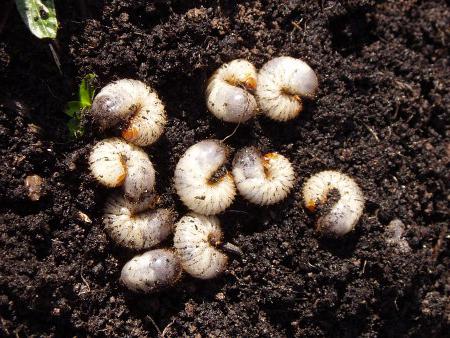

The larvae hibernate, buried in the ground. They turn into pupae the next summer. To do this, the larvae, with the help of short legs, form a cocoon around themselves from the sticky secretion they release. At the end of summer, an adult beetle emerges from the cocoon. Males differ from females only in size: they are larger; in general, sexual dimorphism is not developed in bronzes. The beetle's activity lasts from late spring to mid-summer.
Smelly
Other names: speckled deer or fetid deer. Small shiny black beetle. Body size up to 13 mm. Elytra with many small white spots. The body is covered with dense white bristles. Lives in warm regions, including the south of Russia.
A pest of agriculture, as the larvae eat the roots of plants. The imago feeds on pollen. Years starts in May.
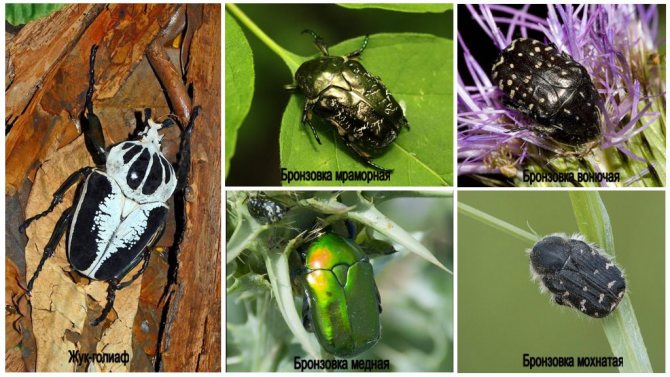

Types of bronze
Where can I find them indoors?
In living quarters, there are many places where the leatherhead hides. The pest nests in warm and dry conditions:
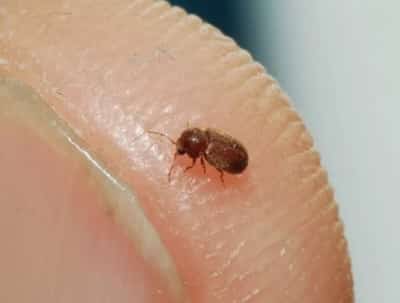

- mattress;
- upholstery of upholstered furniture;
- kitchen area;
- next to the batteries.
Finding bugs in an apartment is difficult. They prefer to hide in hard-to-reach places:
- under the skirting boards;
- in the airspace between the wallpaper and the wall.
Bugs can multiply in frames on windows (wooden), in window sills, pots with plants.
Twirls
This family of small water beetles (on average about 6 mm) has several hundred species, mostly inhabiting tropical reservoirs, but such coleoptera are also found in the northern regions, in particular in fresh water bodies near the Black Sea coast, in Sweden, Norway, Spain. A couple of dozen species live in Russia.
Such beetles, like the previous ones, belong to the suborder of carnivores and feed on small aquatic animals, and not only live, but also dead. Their way of digesting food is very interesting, because the main processes take place not inside, but outside of their body. Twigs inject enzymes into their prey, thereby dissolving it, and then only sucking it in.
The body shape of such creatures is oval, convex; the color is predominantly black, shiny. On the surface of the water, they move energetically, quickly, keep in groups, constantly without rest, describing circles and leading round dances, for which the beetles got their name. And only just anticipating a threat, they dive into the water.
In addition, they can fly, as they are naturally endowed with webbed, well-developed wings. For tirelessness, this waterfowl was awarded the title of the fastest swimmers among their own kind. The largest species of such organisms are found in East Asia, their representatives can grow to a size of two or more centimeters.

